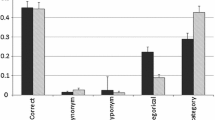Abstract
This paper explores the nature of thematic information made available when a verb is accessed during sentence comprehension. Following Shapiro, Zurif, and Grimshaw (1987), a cross-modal lexical decision (interference) task was employed to examine whether either the number of argument structures or the number of participant (thematic) roles inherent in a verb cause an increase in processing load upon access of the verb. It was determined that there was no evidence for such an increased processing load covarying with the number of argument structures of the verb, at least for those verb types examined in this study. However, there was an increase in processing load as a direct function of the number of participant roles carried by the verb. It is concluded that the participant roles (thematic roles associated with the central meaning of the verb) are stored with the representation of a verb and are made immediately, available upon access of the verb for further processing during comprehension.
Similar content being viewed by others
References
Boland, J. (1991).The use of lexical knowledge in sentence processing. Unpublished doctoral dissertation, University of Rochester, New York.
Boland, J. (1993). The role of verb argument structure in sentence processing: Distinguishing between syntactic and semantic effects.Journal of Psycholinguistic Research. 22, 133–152.
Carlson, G., & Tanenhaus, M. (1988). Thematic roles and language comprehension. InSyntax and semantics: Vol. 21. Thematic relations. New York: Academic Press.
Chomsky, N. (1981).Lectures on government and binding. Dordrecht, The Netherlands: Foris.
Clifton, C., Frazier, L., & Connine, C. (1984). Lexical expectation in sentence comprehension.Journal of Verbal Learning and Behavior, 23, 696–708.
DiSciullo, A., & Williams, E. (1987).On the definition of a word. Cambridge, MA: MIT Press.
Ferreira, F., & Henderson, J. M. (1991). How is verb information used during syntactic parsing? In Simpson, G. (Ed.),Understanding word and sentence. Amsterdam: Elsevier, North Holland.
Fillmore, C. (1968). The Case for case. In Bach, E. and Harms, W. (Eds.),Universals in linguistic theory, New York: Holt, Rinehart and Winston.
Fillmore, C. (1977). Topics in Lexical Semantics. In R. Cole (Ed.)Current Issues in Linguistic Theory (76–138). Bloomington. Indiana University Press.
Foss, D., & Jenkins, C. (1973). Some effects of context on the comprehension of ambiguous sentences.Journal of Verbal Learning and Verbal Behavior, 12, 577–589.
Francis, W., & Kucera, H. (1982).Frequency analysis of English usage. Boston: Houghton-Mifflin.
Goldberg, A. (1992). The inherent semantics of argument structure: The case of the English ditransitive construction.Cognitive Linguistics, 3, 37–74.
Goldberg, A. (1995).Constructions: A construction grammar approach to argument structure. Chicago: University of Chicago Press.
Gruber, J. (1965).Studies in lexical relations. Unpublished doctoral dissertation, MIT.
Hale, K., & Keyser, J. (1986). Some transitivity alternations in English (Lexicon Project Working Paper 7). Cambridge, MA: Center for Cognitive Science, MIT.
Hale, K., & Keyser, J. (1987). A view from the middle (Lexicon Project Working Paper 10). Cambridge, MA:Center for Cognitive Science, MIT.
Hornby, A. (1989).Oxford advnanced learner's dictionary (4th ed. Oxford, England: Oxford University Press.
Kakoff, G., & Ross, J. (1976). Is Deep Structure Necessary? In: J. D. McCawley (Ed.)Syntax and Semantics. 6. Notes from the Linguistic Underground (pp. 159–164). New York. Academic Press.
Mitchell, D. C. (1987). Lexical guidance in human parsing: Locus and processing. In M. Coltheart (Ed.),Attention and performance XII, Hillsdale, NJ: Erlbaum.
Pinker, S. (1989).Learnability ability and cognition. Cambridge, MA: MIT Press.
Rappaport, M., & Levin, B. (1988). What to do with theta-roles. InThematic Relations. Syntax and Semantics (Vol. 21, pp. 7–36).
Rayner, K., Carlson, M., & Frazier, L. (1983). The interaction of syntax and semantics during sentence processing: eye-movements in the analysis of semantically biased sentences.Journal of Verbal Learning and Verbal Behavior, 22, 358–374.
Schmauder, A. R. (1991). Argument structure frames.Journal of Experimental Psychology Learning. Memory, and Cognition, 17, 49–65.
Schmauder, A. R., Kennison, S., Clifton, C. (1991). On the conditions necessary for obtaining argument structure complexity effects.Journal of Experimental Psychology: Learning, Memory, and Cognition, 17, 1188–1192.
Shapiro, L., Brookins, B., Gordon, B., Nagel, N. (1991). Verb effects during sentence processing.Journal of Experimental Psychology: Learning, Memory, and Cognition, 17, 983–996.
Shapiro, L., Zurif, E., & Grimshaw, J., (1987). Sentence processing and the mental representation of verbs.Cognition.
Shapiro, L., Zurif, E., & Grimshaw, J. (1989). Verb processing during sentence comprehension: Contextual impenetrability.Journal of Psycholinguistic Research, 18, 223–243.
Stowe, L. (1989). Thematic structures and sentence comprehension. In G. Carlson & M. Tanenhaus (Eds.),Linguistic structure in language processing. Dordricht, The Netherlands. Kluwer.
Tanenhaus, M., & G. Carlson, & Trueswell, J. (1989). The role of thematic structures interpretation and parsing.Language and Cognitive Processes, 4, 211–234.
Author information
Authors and Affiliations
Additional information
The first author gratefully acknowledges discussion and advice from Adele Goldberg and the support of grant T32 DC 00041 in pursuing this work. The second author acknowledges the support of NIH grant RO1 DC00494 for the work presented in this paper, and the helpful comments and criticisms of a reviewer.
Rights and permissions
About this article
Cite this article
Ahrens, K., Swinney, D. Participant roles and the processing of verbs during sentence comprehension. J Psycholinguist Res 24, 533–547 (1995). https://doi.org/10.1007/BF02143166
Received:
Issue Date:
DOI: https://doi.org/10.1007/BF02143166




